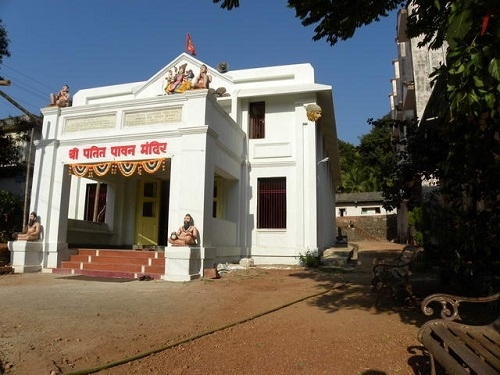Veer Savarkar and Patitpavan Temple- Part 2
Total Views |
In 1931, the Patitpavan temple was established and it had on its trust representation from all castes including ex-untouchables. The Patitpavan temple was constructed with the idea that the practise of community prayers at the temple would help to resolve the issue at the other temples. (Samagra Savarkar Vangmaya, Vol- 3, ed. SR Date, Maharashtra Prantik Hindu Sabha, Pune, 1963-1965, Page 492 & More, Sheshrao. Savarkaranchya Samajkrantiche Antarang, Rajhans Publication, Second Editions, 2010, Page 173)
At the Patitpavan temple the children from the Mahar, Chambhar, Bhangi communities were taught recitation of Sanskrit hymns alongwith children from the Brahman, Kshatriya and Vaishya communities. The Abhishek (sprinkling of holy water) for the Vishnu idol would be carried out amidst the chanting of the hymns by these children in what was labelled as a ritual of the entire Hindu community. The Patitpavan temple was the first temple in India to allow all Hindu people including ex-untouchables unrestricted entry into the sanctum sanctorum of the temple. It followed the principle of "he who is able to perform the Pooja is the priest" – this made sure that Brahminical supremacy was not allowed.

Patit Pavan Mandir, Ratnagiri
The first inter-caste dining for Maharashtra's woman was held in the Patitpavan temple on 21st September 1931. 75 woman were present on the occasion. Just 5 years later, during the Ganesh festival of 1935 this count had gone up to 400 women. On 1st may 1933, Savarkar started a Cafe in the premises of the Patitpavan temple that was open to all Hindus. Ex-untouchables served the food here and it was a condition for anyone coming to meet Savarkar that they should have tea at this Cafe before meeting Savarkar. So by doing this Savarkar breaks the Rotibandi (prohibition of inter-dining) shackle. Savarkar's wife Yamuna alias Mai Savarkar held the traditional 'Haladi-Kunku' ceremony for women from the ex-untouchable communities.
On Phalgun shuddha 5, 22 February, 1931, learned Brahmins under the leadership of Ganeshshastri Modak, a disciple of Masurkar Maharaj, performed the havan and the murtis of Shri Vishnu-Lakshmi or Patitpavan were duly consecrated by the Shankaracharya Dr. Kurtakoti. A grand procession was taken out. Chamar leader Rajbhoj of Pune worshipped the Shankaracharya’s feet with his own hands, a right hitherto denied to untouchables. With this, one more taboo was broken! Patitpavan Mandir is a symbol of Savarkar’s lifelong commitment to social reform. (Godbole, Dr.Shreerang, Veer Savarkar as a social reformer – II, 28 May 2011, Vijayvaani.com)
The 'Times of India' took cognizance of the incident where Shivu Bhangi (an erstwhile caste of cleaners) delivered a religious sermon and Brahmins touched his feet. It reported: "At the Patitpavan temple in Ratnagiri, a new norm has been set by having sermons delivered by a person from the Bhangi community while the people from the upper castes garlanded him and placed their head on his feet. This is unprecedented and is a great revolutionary step by Savarkar."
At that time reciting religious hymns was the privilege of only the Brahmins. In 1930, Savarkar started 'All Hindu Ganpati Festival' in the premises of the Patitpavan temple where religious hymns were recited by a person from the Bhangi community of Hindus. This found a mention in some of the newspapers published from London. (Keer, Dhananjay, Translated by D. P. Khambete, Swatyantraveer Savarkar, Popular Publication, Third Edition, 2009, Page 196). Savarkar also fought to grant access to all ex-untouchable in several old temples in Ratnagiri district. He was a humanist and his only motive behind the social reforms is humanity.

